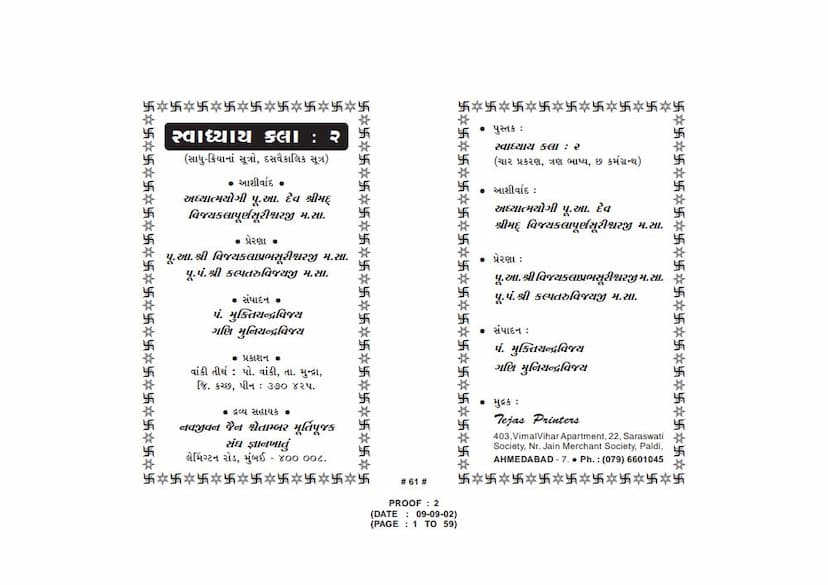Swadhyaya Kala 02
Added to library: September 2, 2025

Summary
Here's a comprehensive summary of the Jain text "Swadhyaya Kala 02" based on the provided pages:
Book Title: Swadhyaya Kala 02 Author(s): Muktichandravijay, Munichandravijay Publisher: Vanki Tirth Mundra
This book, "Swadhyaya Kala 02," is a collection of teachings and practices related to the path of spiritual discipline and study, particularly focusing on the conduct of monks and nuns. It draws heavily from the "Dashavaikalika Sutra" and emphasizes the importance of "Swadhyaya" (self-study and contemplation) as a fundamental pillar of Jain spiritual life.
Core Teachings and Themes:
- The Importance of Swadhyaya: The text repeatedly stresses that Swadhyaya is the very life of a monk. It should be practiced not only during designated study times but also whenever opportunities arise. Monks are encouraged to view every occasion as a chance for spiritual gain through Swadhyaya, just as a merchant views every situation for profit.
- Benefits of Swadhyaya: The book outlines seven significant benefits of Swadhyaya:
- Knowledge of self-interest (आत्महितज्ञानम्).
- Genuine restraint (पारमार्थिकः भावसंवरः).
- Increased spiritual fervor from new knowledge (नूतनज्ञानात् अपूर्वसंवेगवृद्धिः).
- Steadfastness (निष्कम्पत्वम्).
- Excellent austerity (उत्कृष्टं तपः).
- Shedding of karmas (कर्म-निर्जरा).
- The power of teaching others (परोपदेश-शक्तिः).
- Sharing Knowledge: A central theme is the obligation to share acquired knowledge. Knowledge that is not disseminated is considered lost or wasted. Just as wealth not given away is hoarded by a miser, knowledge not shared makes one a miser. Sharing knowledge leads to its growth and perpetuates the teachings.
- Continuity of Tradition: The text highlights the importance of passing down knowledge to future generations through teaching and learning, ensuring the unbroken chain of the Jain tradition. Failure to do so is seen as an offense.
- Spiritual Progress: Swadhyaya is presented as a path to "Samvara" (restraint) and "Nirjara" (shedding of karma), which are the means to liberation. It cultivates deeper spiritual realization and strengthens one's commitment to the path.
- Humility and Devotion: While encouraging the pursuit and sharing of knowledge, the text also cautions against ego. It suggests practicing devotion (भागवती भक्तिः) to remain grounded.
- Dissemination of Teachings: The text mentions the effort involved in compiling and publishing these teachings, initially through photocopies and later through printing, driven by a desire to benefit others. It notes the overwhelming positive reception of these teachings, indicating their profound impact.
- Methodology for Learning: A unique method is introduced for memorizing and recalling scriptural verses. This involves noting the first letter of each stanza or a group of stanzas. This system is presented as an ancient practice used by esteemed scholars and is believed to aid in retention and recall.
- Daily Rituals and Repentance: A significant portion of the book is dedicated to outlining the daily rituals and prayers of monks and nuns, including:
- Samayika: A period of contemplation and restraint.
- Pratikramana: The act of repentance for transgressions committed during the day and night.
- Detailed lists of daily, nightly, monthly (Pakshik), and specific religious observances are provided, along with the associated repentance prayers. These cover a wide range of potential faults related to conduct, speech, thought, and adherence to the five Mahavratas (great vows) and other principles.
- The text includes specific verses and prayers for performing these rituals, such as the "Charitra Sutra" and detailed lists of "Aticharas" (transgressions) for various rituals.
- The Dashavaikalika Sutra: The latter part of the book includes sections from the Dashavaikalika Sutra, covering various chapters (adhyayana). These chapters focus on:
- Drumpushpika Adhyayana: Illustrates detachment and the transient nature of worldly pleasures using the analogy of a bee collecting nectar from flowers without harming them.
- Shramanyapushpika Adhyayana: Discusses controlling desires and the importance of detachment.
- Shullakachara Adhyayana: Details the conduct and renunciatory practices of ascetics.
- ChhJeevanikaya Adhyayana: Focuses on the principles of non-violence towards all living beings, categorizing them into six life-forms (earth-bodied, water-bodied, fire-bodied, air-bodied, plant-bodied, and mobile beings).
- Pindeshana Adhyayana: Deals with the proper conduct and considerations for collecting alms (food and sustenance) as a monk. It outlines rules for alms-gathering, avoiding various imperfections and undesirable situations.
- Mahachara Katha Adhyayana: Discusses the importance of righteous conduct and the consequences of improper actions.
- Suvakya Shuddhi Adhyayana: Emphasizes the importance of pure and appropriate speech, cautioning against uttering falsehoods, gossip, and divisive talk.
- Acharaprasiddhi Adhyayana: Details the correct behavior and practices related to conduct and discipline.
- Vinaya Samadhi Adhyayana: Explores the importance of humility, respect for elders and teachers, and maintaining equanimity.
- Sabhikshu Adhyayana: Depicts the ideal conduct of a monk.
- Chulika: Concluding supplementary teachings.
In essence, "Swadhyaya Kala 02" is a practical guide for Jain ascetics, reinforcing the foundational principles of Swadhyaya, ethical conduct, repentance, and devotion, all aimed at achieving spiritual liberation. It serves as a spiritual manual, deeply rooted in scriptural wisdom and designed to guide practitioners on their path to enlightenment.